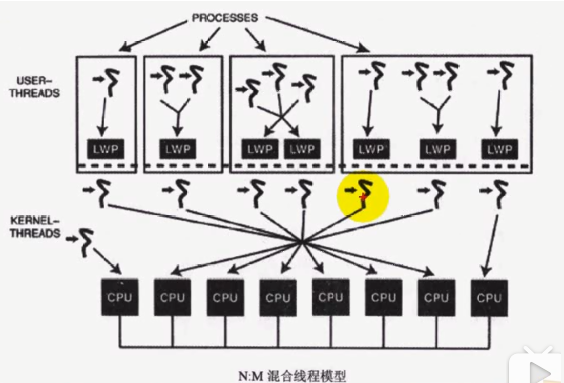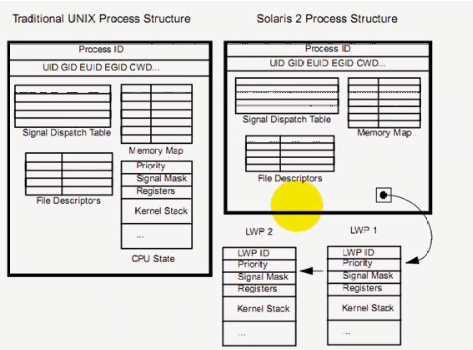1 线程与进程
1.1 线程和进程对比
| 进程 | 线程 |
|---|---|
| 程序的一次动态执行过程 | 一个进程内部的控制序列 |
| 一个进程只能对应一个程序, 一个程序可以有多个进程实例 | 一切进程至少都有一个线程 |
| 资源竞争的基本单位 | 程序执行的最小单位 |
| 进程间不共享数据 | 线程共享进程数据,也拥有自己的结构数据 |
| fork新进程后,有自己的变量和PID,完全独立于父进程 | 创建新线程后,有自己的堆栈,但与父进程共享全局变量,文件描述符,信号处理和当前工作目录状态 |

1.2 线程优点
- 创建新线程代价比创建新进程小
- 线程间切换代价小
- 线程占用的资源少
- 线程能充分利用多处理器的并行数量。计算密集型应用,将计算分解为多个线程实现,可在多处理器系统运行。
- 在等待慢速IO操作时,程序可执行其他任务。IO密集型应用,为了提高性能,将IO操作重叠。线程可以同时等待不同的IO操作。
1.3 线程的缺点

2 线程模型
2.1 N:1用户线程模型
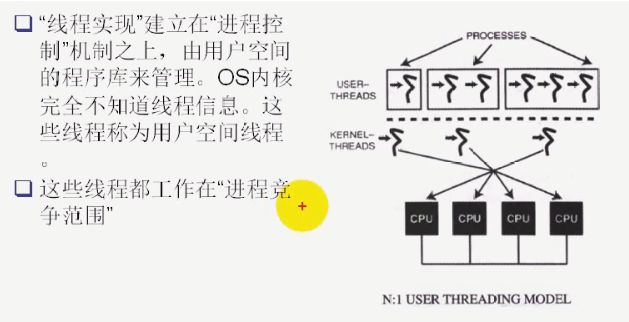

2.2 1:1核心线程模型

2.3 N:M混合线程模型
该模型提供了两级控制,将用户线程映射为系统的可调度体(称为LWP轻量级进程)以实现并行,LWP再一一映射到核心线程。
POSIX线程就是使用这种模型。
3 POSIX线程
3.1 POSIX线程API
头文件:
#include <pthread.h>
同时编译时需要加上链接线程库的命令:-lpthread。
3.1.1 pthread_create
原型:int pthread_create(pthread_t *thread, const pthread_attr_t *attr, void *(*start_routine) (void *), void *arg);
功能:创建一个新线程
返回值:成功返回0, 失败返回错误码
参数:
- thread:返回的线程ID
- attr:设置线程属性,NULL代表使用默认属性
- start_routine:函数指针,即线程启动后要执行的函数
- arg:函数指针需要的参数
注意:pthread相关的函数出错时不会设置全局变量errno,而是通过返回值。
3.1.2 pthread_join
原型:int pthread_join(pthread_t thread, void **retval);
功能:等待创建的新线程结束,类似进程的waitpid函数
返回值:成功返回0, 失败返回错误码
参数:
- retval:线程的exit状态,return的返回值或pthread_exit的retVal,可以置为NULL
3.1.3 pthread_exit
原型:void pthread_exit(void *retval);
功能:终止线程,类似进程的exit函数。也可以调用return
返回值:无返回值,跟进程一样,线程结束无法返回到它的调用者
参数:
- retval:返回状态,不能指向一个局部变量
3.1.4 pthread_self
原型:pthread_t pthread_self(void);
功能: 返回本线程的id
返回值: 成功返回线程id
3.1.5 pthread_cancel
原型:int pthread_cancel(pthread_t thread);
功能:取消一个执行中的新线程
返回值:成功返回0, 失败返回错误码
参数:
- thread:线程id
3.1.6 pthread_detach
原型:int pthread_detachl(pthread_t thread);
功能:将一个线程与调用者分离
返回值:成功返回0, 失败返回错误码
参数:
- thread:线程id
3.2 线程属性设置

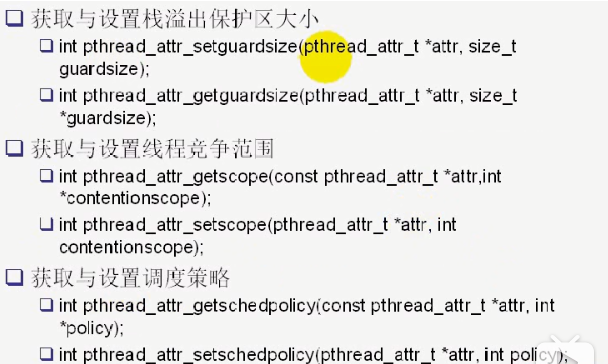


3.3 线程私有数据
线程除了共享其他线程和主线程的信息之外,还有128个key-value的结构(PTHREAD_KEY_MAX决定每个系统支持的个数)可以保存本线程私有的数据,这些数据不被其他线程访问,但是可以被本线程的所有函数访问,类似于本线程中的全局变量。
结构如下:
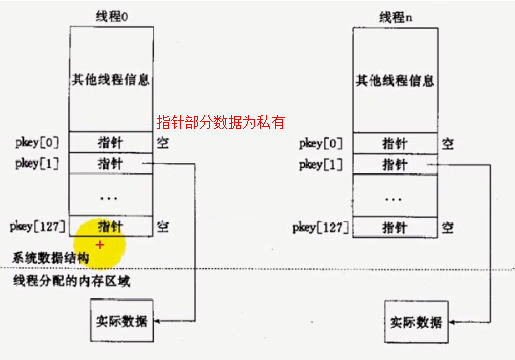
如下函数用于设置key-value数据段的数据:
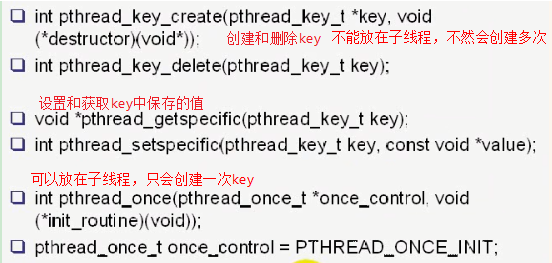
3.4 代码示例
3.4.1 线程创建
#include "common.h"#include <pthread.h>void* thread_function(void* arg){for (int i=0; i<20; i++){printf("slave thread said B\n");fflush(stdout);usleep(20);}sleep(3);return 0;}int main(){pthread_t tid;int ret = pthread_create(&tid, NULL, thread_function, NULL);if (ret != 0){//错误处理printf("pthread_create failed, error message: %s\r\n", strerror(ret));exit(EXIT_FAILURE);}for (int i=0; i<20; i++){printf("master thread said A\n");fflush(stdout);usleep(20);}//主线程等待新创建的线程结束,不然会直接终止ret = pthread_join(tid, NULL);if (ret != 0){//错误处理printf("pthread_join failed, error message: %s\r\n", strerror(ret));exit(EXIT_FAILURE);}return 0;}
3.4.2 私有数据区操作
#include "common.h"#include <pthread.h>struct tsd{pthread_t tid;char* str;};pthread_key_t key;void destroy_func(void* value){//删除key时调用该函数printf("destroy the key here\n");free(value); //释放malloc的内存,这里value就是保存到key中的数据的指针}void* thread_func(void* arg){tsd* value = (tsd*)malloc(sizeof(tsd));value->tid = pthread_self();value->str = (char*)arg;//设置key的值printf("%s set the value[%p] of the key\n", (char*)arg, value);pthread_setspecific(key, value);//获取key中的值sleep(2);value = (tsd*)pthread_getspecific(key);printf("tid=0x%x, str=%s\n", value->tid, value->str);return NULL;}int main(){key = pthread_key_create(&key, destroy_func);pthread_t t1;pthread_t t2;pthread_create(&t1, NULL, thread_func, (void*)"thread1");pthread_create(&t2, NULL, thread_func, (void*)"thread2");pthread_join(t1, NULL);pthread_join(t2, NULL);return 0;}
4 线程池实现
线程池中有多个线程,用于以下用途:

线程池本质上也是生产者和消费者模型,生产者线程向任务队列添加任务,一旦有任务到了,如果有等待线程就唤醒执行任务;如果没有等待线程并且线程池未达到阈值,就创建新线程执行任务。
